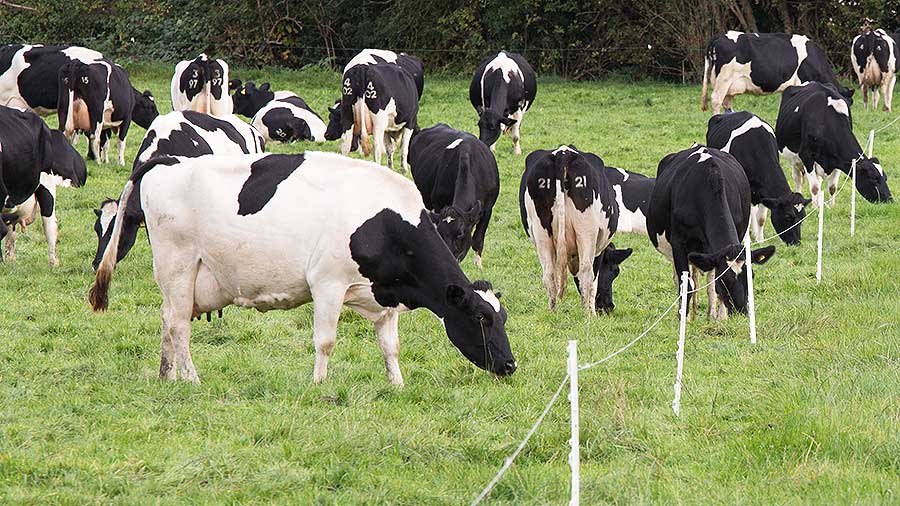Advice on setting up a dairy grazing rotation
 © Tim Scrivener
© Tim Scrivener Rotational grazing involves dividing a field into smaller paddocks and rotating livestock around these paddocks.
It can not only improve weight gains compared to traditional set stocking, but resting paddocks allows grass to recover quicker.
James Daniel from Precision Grazing offers advice on how to set up a rotational grazing system and what to do in different weather scenarios.
See also: A guide to mob grazing livestock
Measuring grass
Rotational grazing requires good infrastructure and keeping an eye on residuals. Measuring grass – ideally once a week – is a must.
Turning youngstock out without measuring and monitoring will not achieve cost savings or hit target growth rates, says Mr Daniel.
“Farmers not measuring their grass growth are gambling with a chip that’s worth £2,000 to £5,000.
By measuring you are taking away the guesswork allowing the decisions you make to be more accurate.
“Information from pasture management software won’t tell you what to do, but it gives you some direction and the confidence to action certain decisions, such as when to remove a paddock for silage, if nitrogen fertiliser is needed, or whether you should buffer feed.”
Grazing targets
1. Consider pre-graze targets
It is important to make sure the grass being fed is at the correct height for the age of stock to maximise their intakes.
The pre-grazing target (entry cover) for youngstock aged six to 12 months on a ryegrass clover sward is about 2,500kg DM/ha, or about the height of a Coke can.
For herbal leys this increases to 4,000kg DM/ha or wine bottle height. Above this, and the quality can start to reduce.
2. Post-grazing targets
The post-grazing target (residual or exit cover) for a ryegrass clover sward should be 1,500kgDM/ha or “golf ball height”. For herbal leys this increases to 2500kgDM/ha or “Coke can height”.
Rotation length
After grazing a paddock, plants should be left to fully recover. For ryegrass plants this means not grazing before they reach the 2.5 leaf stage (about 2,500kgDM/ha).
In the growing season, this normally means a rotation length of 21-30 days. For herbal leys, expect this to be 25-36 days.
If you are getting around a rotation too fast, you need to take action by reducing the demand per hectare by increasing the grazing area by incorporating silage fields into the rotation or buffer feed.
Setting up temporary or permanent electric fencing to create a paddock grazing system for youngstock is the most effective way to enable good grazing management.
As a guide for ryegrass and clover pastures, you will need eight paddocks. Spending three days a paddock will mean a 24-day rotation.
For herbal leys, you will need 10 paddocks. Spending three days a paddock will mean a 30-day rotation.
As heifers grow and pasture growth declines later in the season (July onwards), you should plan to add two to three more paddocks.
Calculations
To work out the total area required and size of the paddocks you can do a quick calculation.
Example:
- Available grass: 1,000kg DM/ha
- Number of heifers = 50
- Average weight = 300kg
- Target daily liveweight gain (DLWG) = 0.8kg/day
- Demand = 2.2% of weight = 6.6kg DM/heifer/day
1. Work out feed demand
A heifer aged 6-12 months old, with target DLWG of 0.8kg will require 2.2% of her body weight in dry matter, assuming pasture quality is >11ME (which it will be when pre- and post-grazing targets are met).
Demand: 2.2% x 300kg = 6.6kgDM/heifer/day
50 heifers x 6.6kgDM = 330kg DM/day
2. Work out the area required
Divide the group’s daily requirement by the known or estimated average pasture growth rate* (for the grazing season) for example, 330kg DM / 50kg* DM/ha = 6.6ha
*grass growth information for your region is available from GrassCheck GB or Farming Connect Pasture Project (Wales).
3. Work out the paddock size required
Total area required divided by the number of paddocks:
6.6ha ÷ 8 paddocks = 0.8ha/paddock (two acres)
4. Work out your rotation length
Performance will be improved by measuring paddocks each week to calculate the current pasture growth rate. This can be used to work out the actual rotation length required and identify if there is a pasture surplus or deficit.
First calculate the available pasture per ha, such as for ryegrass and clover sward.
- Target pre-grazing cover (entry) 2,500kg DM/ha
- Target post-grazing cover (residual) 1,500kg DM/ha
Pasture Available = 2,500kg DM/ha – 1,500kgDM/ha = 1,000kgDM/ha
Rotation length is calculated from the amount of grass available per hectare, divided by the grass growth rate, then adding the on-time per paddock:
1,000kgDM/ha ÷ 40kg DM/ha = 24 days
Three day on-time = 24 days + 3 days = 27 days
A growth rate of 40kgDM/ha is less than the target of 50kgDM/ha based on the groups demand.
Therefore, this indicates a feed deficit, which can be managed by extending the rest period by:
- Grazing any paddocks with above target pasture covers
- Providing buffer feed
- Adding in some additional area to create an extra paddock.
If the growth rate had been above demand, this would require a shorter rest period which can be achieved by:
- Reducing the on-time (grazing plants at two-leaf stage acceptable for short periods to control a surplus)
- Remove a paddock to be cut for silage (normally within seven days)
- Add more animals to the group.
